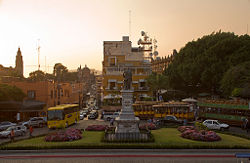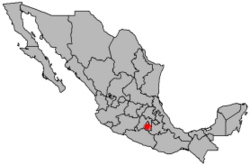Cuernavaca
| Cuernavaca | |
 |
|
 |
|
| Mexican State | Morelos |
|---|---|
| Government | |
| - Mayor 2006-2009 | Jesús Giles Sánchez |
| Area | |
| - City | 151.2 km² (58.38 sq mi) |
| Elevation | 1,548 m (4,856 ft) |
| Population (2005) | |
| - City | 332,197 city; 349,102 municipality |
| - Metro | 787,556 |
| Website: http://www.cuernavaca.gob.mx | |
Cuernavaca (Classical Nahuatl: Cuauhnāhuac IPA: [kʷaw̥.'naː.wak]) is the capital and largest city of the state of Morelos in Mexico. As of the 2005 census, the population of the city was 332,197; the municipality's entire population was 349,102 in an area of 151.2 km2 (58.4 sq mi) that includes numerous small localities outside the city, like Ocotepec, where interesting religious celebrations take place, like the Day of the Dead in the first days of November.
Cuernavaca is located about 85 km (53 mi) south of Mexico City on the M-95 freeway. It is known as "the city of eternal spring" because of its consistent 27°C (80°F) weather year round. Cuernavaca sits in the heart of central Mexico, and is surrounded by some of the most beautiful and culturally rich regions of the country.
The city's name comes from Nahuatl Cuauhnāhuac "place near trees" (pronounced [kʷawˈnaːwak]), the name of the pre-Columbian altepetl at the location. The name was altered to Cuernavaca by influence of the Spanish words cuerno "horn" and vaca "cow".
Contents |
Locale
Cuernavaca lies about 700 metres (2,300 ft) lower than Mexico City, and therefore serves as a popular refuge from the cold for inhabitants of Mexico City. It attracts visitors from around the world for its art, history, and Spanish language schools. Several interesting excursions to nearby attractions are easily managed within a two-hour drive: North America's oldest and most populous city Mexico City to hovering 6,000-metre (20,000 ft) volcanoes topped by Nahuatl ruins like Tepoztlán or Xochicalco— are just a couple of the possibilities within a short distance from the heart of this old, charming city.
Cuernavaca is appreciated for its historical richness, striking scenery, vibrant life, and delightful climate. Surrounded by undulating hills and cut by narrow, cobbled streets, Cuernavaca is a quaint colonial remnant. A wide variety of activities are available with all of the normal services of a modern city. This balance of ancient and new has protected the historical value of the city while offering modern amenities.

Economy
While the chief economic activities in modern day Cuernavaca center around manufacturing and services, some agricultural activities of old continue. Cortés introduced sugar cane cultivation to the area, and African slaves were brought in to work in the cane fields, by way of Spain's Caribbean colonies. His sugar hacienda still stands but has been converted to the impressive Hacienda de Cortés. Sugar is still a main agriculture product in addition to corn (maize), beans, and tropical fruits. Floriculture and beekeeping are also important. Manufactures include processed foods, pharmaceuticals, clothing, textiles, and automobiles.
Tourism is also a driving force in Cuernavaca. This is mostly due to its warm weather and many water parks that attract thousands of visitors coming from Mexico City.
Architecture
The city has examples of ancient Aztec and Tlahuica cultures (such as at Teopanzolco) as well as colonial buildings. Emperor Charles V gave Cuernavaca to Hernán Cortés as a fief, and in 1532 the conquistador built the Palacio de Cortés, now the Museo Regional de Historia de Cuauhnahuac (Historical Museum of Cuauhnahuac). The museum features a mural by Diego Rivera depicting the conquest of Mexico, mammoth remains, and items from contemporary Indigenous cultures.
Cuernavaca's downtown cathedral dates from 1552. Murals depict the journey of Mexican Saint Felipe to Japan. At the 11:00 mass on Sundays, a mariachi band accompanies the proceedings.
Artist Robert Brady lived and died in a former 16th century meteorological observatory of the Franciscan seminary behind the Casa de la Torre, leaving a fascinating and rich collection of art he had collected over his lifetime.[1] Works by Diego Rivera, Frida Kahlo, Paul Klee and Francis Toledo are among the 1400 pieces in the collection. This museum was second choice as the location for Mexico's Guggenheim Museum, which is being constructed in Guadalajara, Jalisco.
The World Association of Girl Guides and Girl Scouts world centre Our Cabaña opened in 1957.
Education and scientific research
The Universidad Autonóma del Estado de Morelos (UAEM) is the state university located north of Cuernavaca. It has several schools including Chemistry and Pharmaceutics, Mathematics, Biology, Physics, a Law School and a Medicine College.
The National Autonomous University of Mexico (UNAM) has a satellite campus located in Cuernavaca, which is aimed at research and graduate studies. It also has an undergraduate program in genomics.[2]
Cuernavaca is the home of the following research centers: Center for Genomic Sciences (UNAM),[3] the Institute of Biotechnology (UNAM),[4] the Institute of Physical Sciences (UNAM),[5] the Center for research in Energy (UNAM), the Institute of Mathematics (UNAM), the Center for Research in Engineering and Applied Sciences (UAEM),[6] and the National Institute of Public Health. Cuernavaca has the highest concentration of scientists and researchers in Latin America.
Transportation
The city's bus system is economical and easy to use. Bus destinations from Cuernavaca include very regular services to Mexico City (every 15 minutes) as well as services to Puebla, Tepoztlan, Taxco, Acapulco and other destinations throughout Morelos. There is a toll road. Cuernavaca is no longer served by rail services. Cuernavaca has developed air-transportation service throughout the last few years due to its proximity to Mexico City. The airport in Cuernavaca General Mariano Matamoros Airport is a national airport in the Southern-east area of the city and it is considered as alternate to Mexico City International Airport. Viva Aerobus has scheduled flights to Monterrey.
Famous residents
- Daniel Cerda Covarrubias (1986 - Till Now)
- Hernán Cortés (1485-1547)
- Emperor Maximilian (1832-1867), Jardin Borda Cultural Center is located in his former residence in this city.
- Barbara Hutton (1912-1979), Granddaughter of Frank Woolworth built a luxurious Japanese-style palace on a 30 acre (120,000 m²) estate in Jiutepec, in the outskirts of Cuernavaca in 1959.
- Robert Brady (1928-1986) Iowa native who founded museum that bears his name in downtown Cuernavaca.[1]
- Maurice Ascalon (1913-2003), the Israeli sculptor and industrial designer, spent the last years of his life in Cuernavaca, where he resided with his son, the artist Adir Ascalon.
- Erich Fromm lived in Cuernavaca around 1950.
- Chicago mobster Sam Giancana spent seven years (1967-74) in exile on a lavish estate until the Mexican government (under pressure from the US Justice Department) had him deported to the United States.
- Helen Hayes, noted American actress of stage and film, owned a home in Cuernavaca for many years.
- Ivan Illich founded the Centro Intercultural de Documentación (CIDOC) in Cuernavaca in the early 1960s. This institution served as his base for many years.
- Tamara de Lempicka (May 16 1898 – March 18 1980), noted Art Deco painter, spent the last two years of her life in Cuernavaca.
- Jazz figures Charles Mingus (1922-1979) and Gil Evans (1912-1988) both died in Cuernavaca after suffering from Lou Gehrig's disease and peritonitis, respectively.
- Mohammad Reza Pahlavi, the exiled Shah of Iran.
- Manuel Puig, an Argentine writer, moved to Cuernavaca in 1989, and died there a year later.
- Charles Samuels, an American writer, moved to Cuernavaca in 1974, and died there in 1982.
- Natasha Gelman, wife of Jacques Gelman, spent her last years in Cuernavaca, thus making her final wish to create a museum with part of her art collection in Cuernavaca.
- Gloria Lasso, Spanish-born french singer.
- Malcolm Lowry, English writer, moved to Cuernevaca in 1936 and made Quauhnahuac the fictional locale of his novel, Under the Volcano.
- Sergio Méndez Arceo, Mexican Bishop, activist and human rights supporter.
- Enrique Semo, Mexican historian.
- Rosa Eleanor King (1867-1955), an English woman who moved to Mexico, was the owner of the Hotel Bella Vista during the Mexican Revolution of 1910-17. She wrote of her experiences in her best-selling book, "Tempest Over Mexico" (1935).
Pop Culture References
- RBD: La Familia, a sitcom starring RBD. It was referenced in Episode 12
- Vantage Point (film), Columbia Pictures 2008
- In the TV series Buffy the Vampire Slayer, episode 12 of Season 3, Helpless, Buffy experiences an unexpected loss of her powers. She describes herself as being off her game: "My game's left the country. It's in Cuernavaca".
- In the movie Men in Black, the smuggler in the opening of the film tells a border patrol official that he is returning from "fishing in Cuernavaca."
- Mentioned in the Ross Thomas novel "THE SINGAPORE WINK" avon press 1969
Mentioned in Warren Zevon's song Veracruz from Excitable Boy album, which was referenced in the Wickepidia article about the United States Occupation of Veracruz in 1914.
Notes
- ↑ 1.0 1.1 "FUNDACION ROBERT BRADY Casa Museo, Centro Cultural". Retrieved on 2007-12-06.
- ↑ "Licenciatura en Ciencias Genómicas". Retrieved on 2007-12-01.
- ↑ "Center for Genomic Sciences". Retrieved on 2007-12-01.
- ↑ "Instituto de Biotecnología". Retrieved on 2007-12-01.
- ↑ "Instituto de Ciencias Físicas". Retrieved on 2007-12-01.
- ↑ "Centro de Investigación en Ingeniería y Ciencias Aplicadas". Retrieved on 2007-12-01.
Adalberto Rios Szalay. Cuernavaca-Mexico (1943) Born. International Photographer and writer. Photographer of the Book: Mexico Visto y Andado: http://www.amazon.com/Mexico-Andado-Jorge-Alberto-Lozoya/dp/8497851234
References
- Link to tables of population data from Census of 2005 INEGI: Instituto Nacional de Estadística, Geografía e Informática
- Morelos Enciclopedia de los Municipios de México
- Some Tax records between 1686-1689 from El Marquesado del Valle de Cuernavaca in the Virreinato de la Nueva España
External links
- Ayuntamiento de Cuernavaca Official website
|
|||||